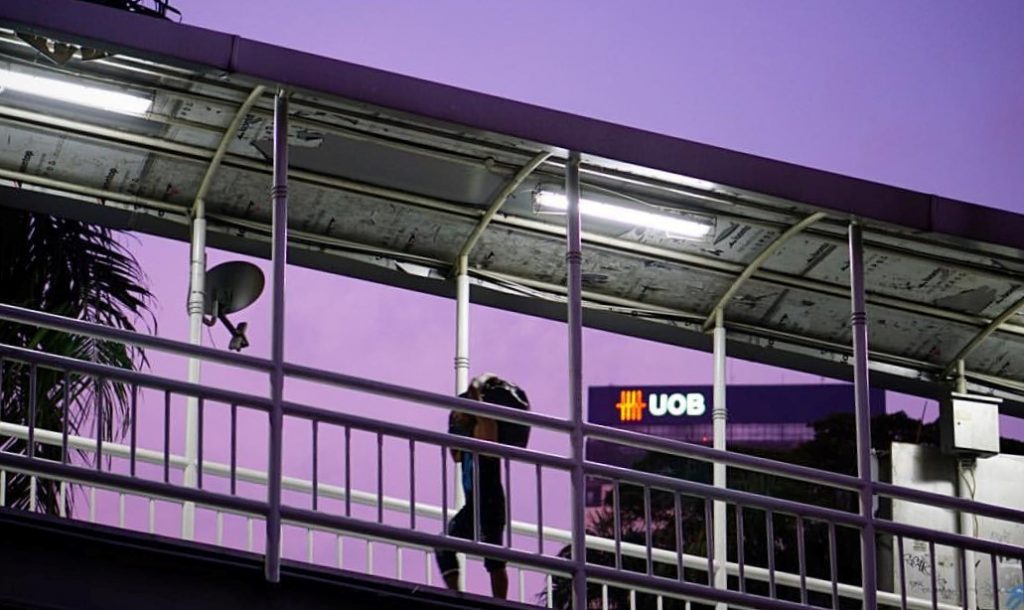Interpretations of the results of the 19 April gubernatorial election in Jakarta have differed between observers who see the salience of class divides as the main lesson of the election, and those who put primacy on the campaign’s sectarian and ethnic dimensions. Few commentators have dismissed identity divides altogether; rather, the debate has been one of emphasis. Ian Wilson, for example, wrote in New Mandala that class and inequality were underrated ‘shaping factors’ in Ahok’s loss. Azis Anwar Fachrudin built upon Wilson’s analysis of how issues of economic injustice and identity were instrumentalised by political elites.
We think that the evidence points overwhelmingly to a critical role for religion, and a campaign that focused on Ahok’s ethnic identity as both a Chinese Indonesian and a Christian. This argument was laid out most clearly by our ANU colleague Marcus Mietzner in a public discussion with Ian Wilson at Murdoch University.
In this post, we use exit poll data collected on election day by Indikator Politik Indonesia (and generously shared with us by Burhanuddin Muhtadi) to demonstrate just how clearly religious motivations influenced voters’ decisions. We show striking divisions between Muslim and non-Muslim voters, and reveal how affluent Muslim voters were just as likely as poor Muslim voters to oppose Ahok.
But scholarly analysis of the Jakarta election can’t stop at the exit polls; rather, we propose that these survey data offer an ideal starting point from which to explore the complex interplay between ethnoreligious divides, identity politics, and ideas about inequality and economic justice in contemporary Indonesia. When we talk about ‘sectarian’ voting, what do we really mean? Is there a class dimension to sectarian politics in Indonesia? And how are political debates about economic justice framed by Indonesia’s leaders?
We argue here that class and ethnic identity do intersect in Indonesia, and political elites are increasingly willing to highlight and politicise this intersection.
Let’s turn first to the numbers.
Exit polls from 19 April
What would a class divide look like in exit poll results? One clear marker of class distinction in Indonesia is educational attainment or, even more simply, monthly income. We might expect substantially greater approval for Ahok among economically better off or more educated voters, and low approval numbers from the poor. But the table below shows, for instance, that respondents who only have up to primary school educations are less likely to be dissatisfied with Ahok than those with university degrees. The two groups are very satisfied with Ahok’s job performance at about the same rate. Middle and high school graduates appear more ambivalent about Ahok’s performance, but the difference is not huge.
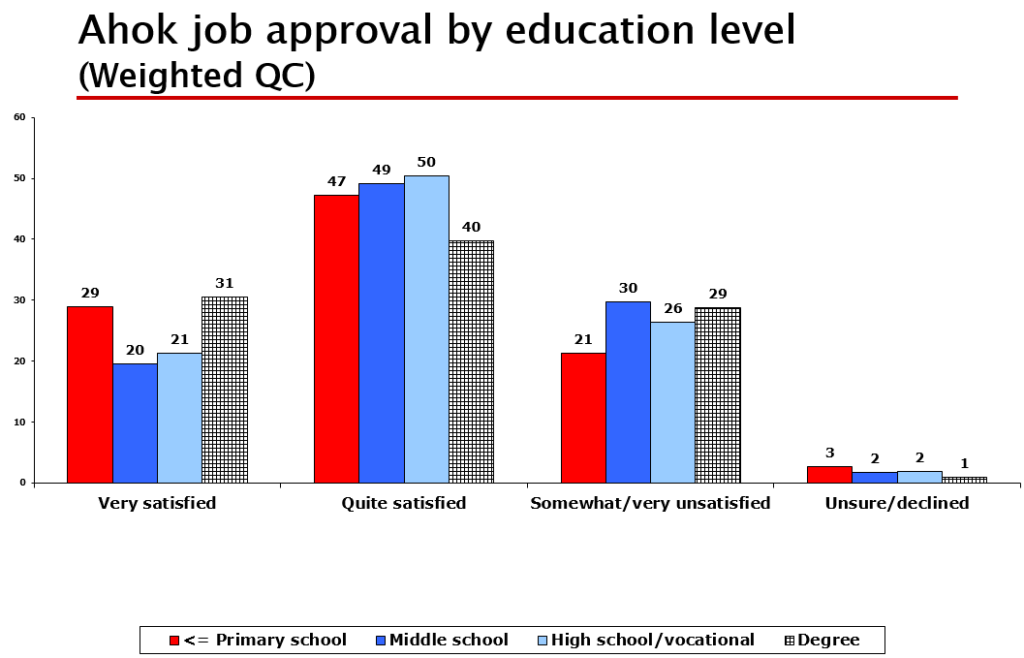
A class divide is similarly not apparent when we look at perceptions of Ahok’s performance within different income groups. The poorest voters, earning less than 2 million rupiah a month (less than the legal minimum wage in Jakarta) are mostly ‘quite’ or ‘very’ satisfied with Ahok. Moreover, among the minority of voters who disapproved of Ahok, there seems to be no large divide among income groups: if anything higher income groups are more dissatisfied.
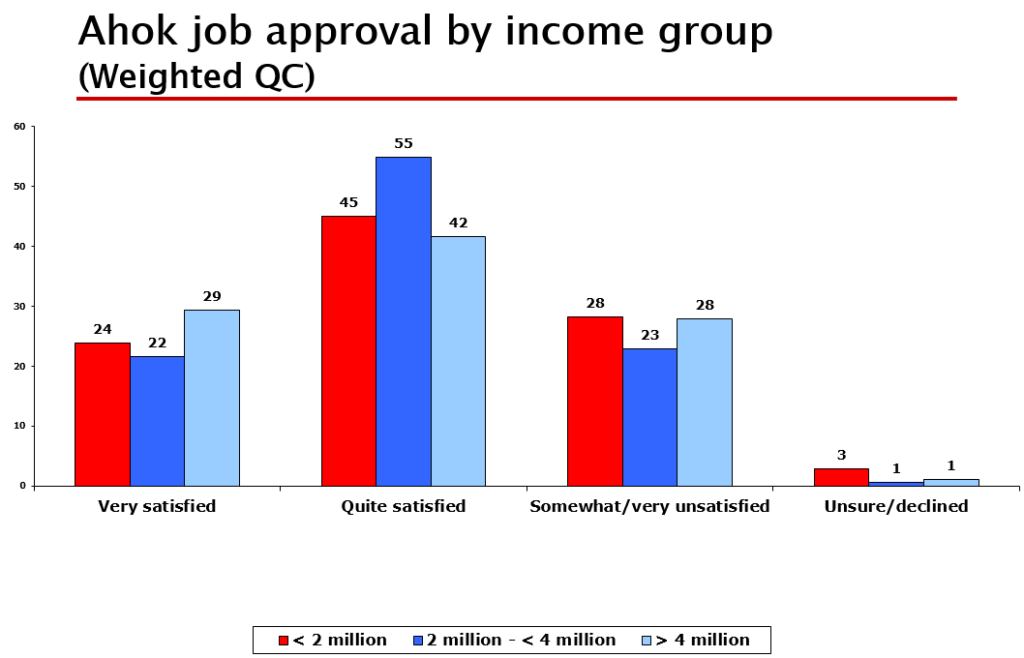
Not only that, a slight majority of respondents who voted for Anies Baswedan and Sandiaga Uno were satisfied with Ahok, as the table below shows. This finding is noteworthy, and raises the question: if they were happy with Ahok’s performance, why vote for the opposition candidate?
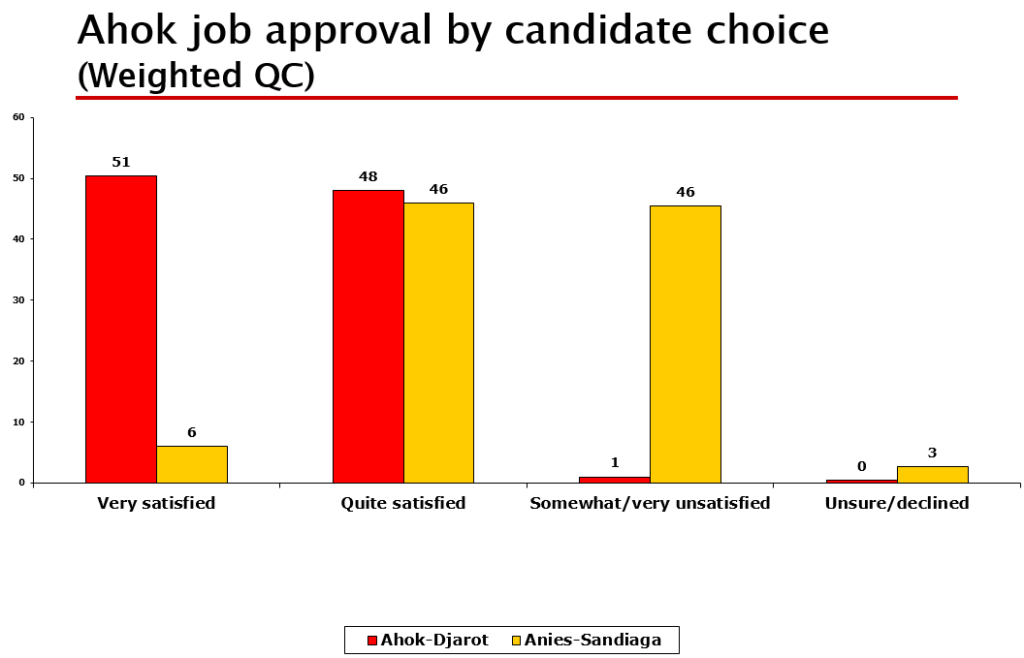
Indeed, even the Muslim electorate seemed happy with Ahok’s performance in office. Two thirds of them, the table below shows, answered ‘quite’ or ‘very’ satisfied. But Muslims made up practically all of those voters who disapproved of Ahok: he had an approval rating of 97% among Indikator’s non-Muslim respondents.
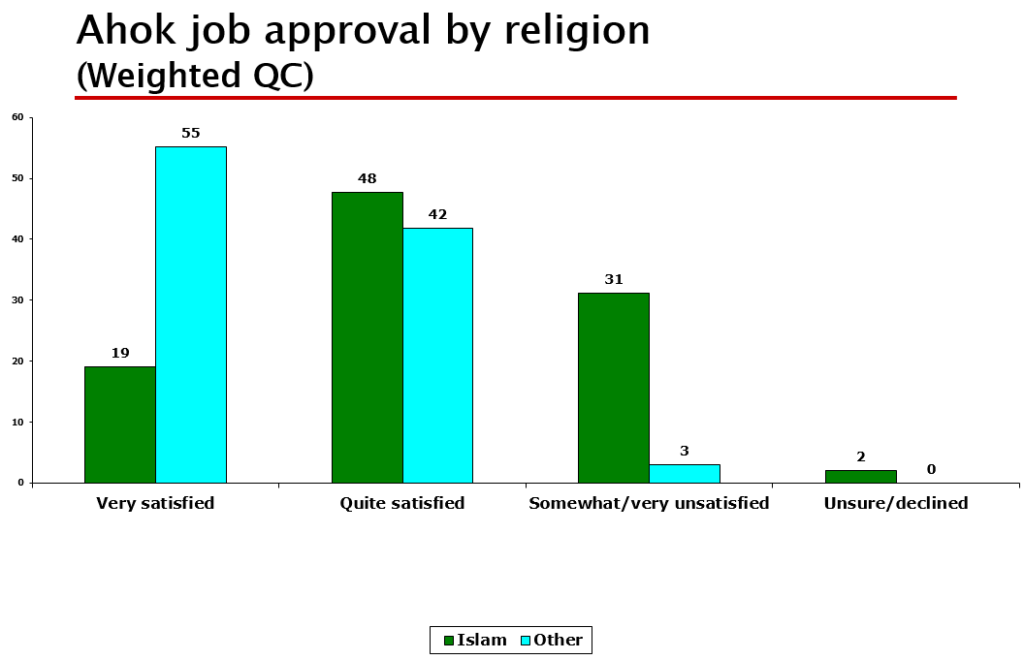
Much was made about the fact that there was an inverse relationship between income and likelihood of voting Anies—as those claiming a class divide would expect. Indeed, Indikator’s exit poll data show this; the table below shows Anies’s vote declining as you go up the income scale.
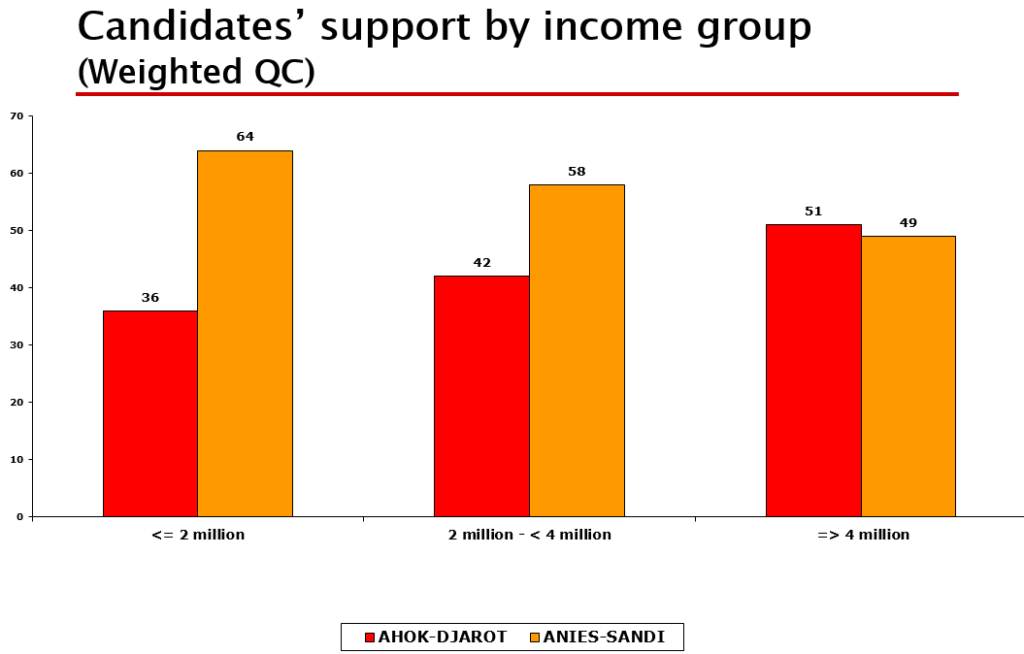
But when we disaggregate these data by religion, a different picture emerges. The tables below separate Muslim and non-Muslim voters and compare how they voted by education levels and income.
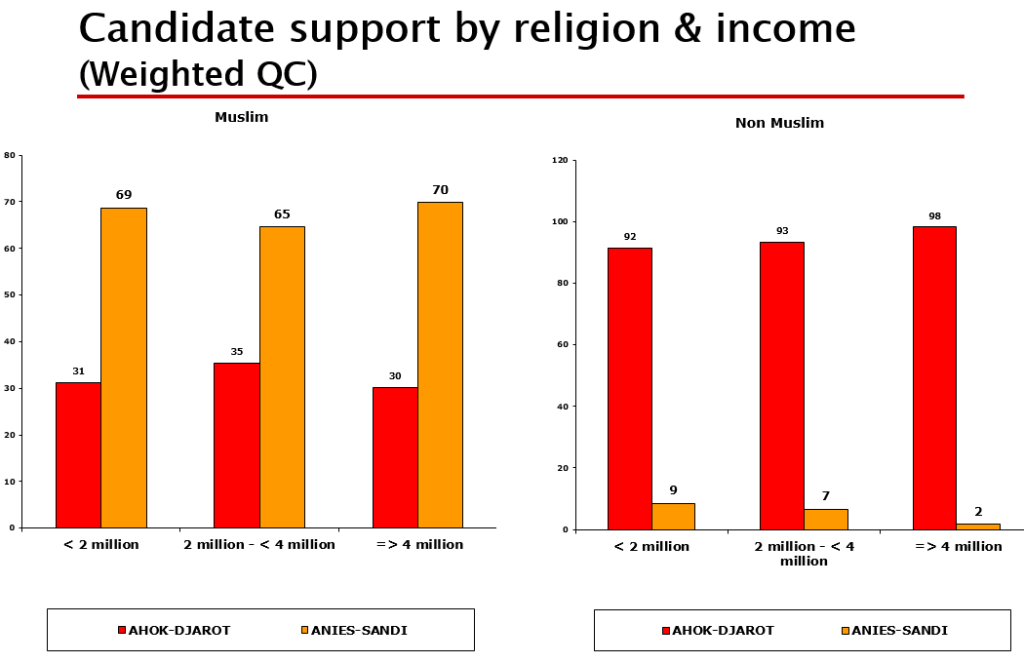
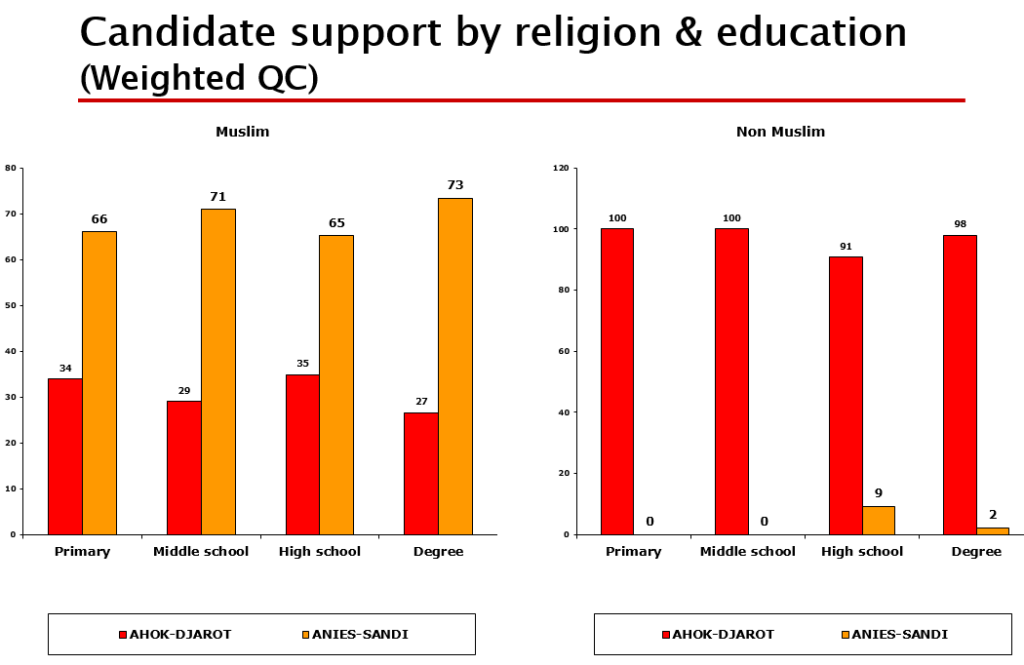
The findings are clear: Muslims were uniformly far more likely to vote against Ahok regardless of their income or educational levels. Likewise, non-Muslims were uniformly far more likely to vote for Ahok regardless of income and education. Within the Muslim electorate, there appears to have been no class divide whatsoever. The poorest and richest voters were just as likely to vote against Ahok. By implication, the overall even split of higher income and degree-holding voters’ support between Anies and Ahok (see table ‘Candidates’ support by income group’) can be explained by Ahok’s overwhelming popularity with affluent non-Muslims, and by the disproportionate representation of non-Muslims among upper class Jakartans.
Recall that Ahok maintained a 67% job approval rating among all Muslims in this poll. And remember that 52% of the respondents who chose Anies did so despite being satisfied with Ahok’s performance (see table ‘Ahok job approval by candidate choice’). Why did these voters reject a governor with whom they were satisfied? The chart below contains a lot of information, but for our purposes the leftmost two columns are most important. These data tell us that 39% of those 52% of Anies voters who were happy with Ahok’s job performance said that they voted for Anies for religious reasons. Most Anies voters who were unhappy with Ahok’s job performance said they voted Anies for religious reasons too—which raises some questions about whether religious prejudice was affecting voters’ assessment of Ahok’s track record.
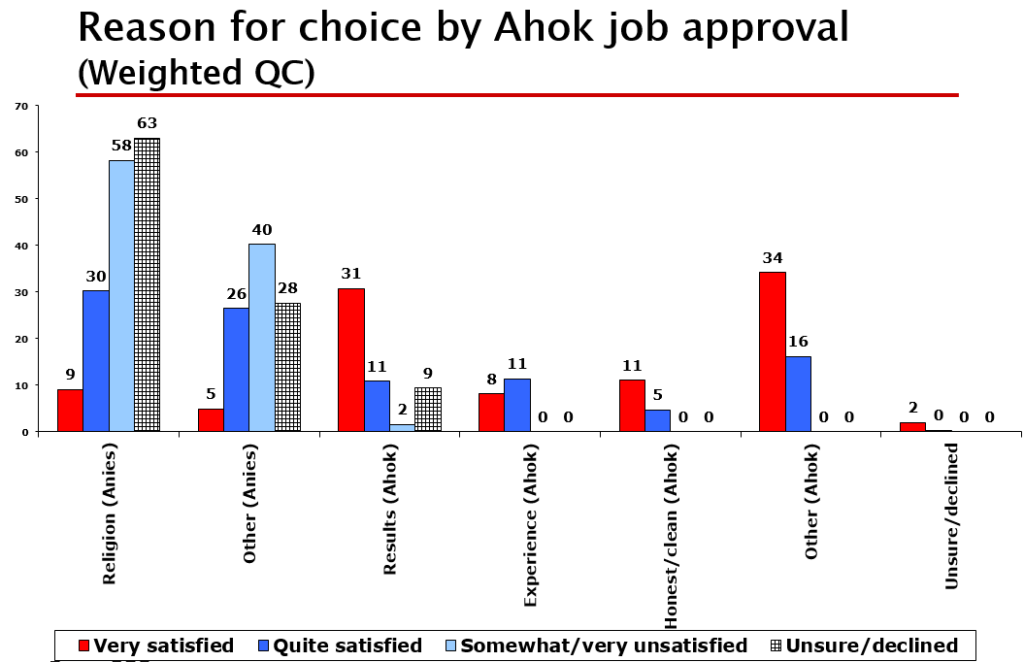
It’s significant to note that when voters cited religion as the major factor determining their vote, they did so unprompted. Indikator’s interviewers did not present respondents with a list of issues to choose from. Rather, these answers were ‘top of mind’—voters were asked to name the most important factor in their vote and their reasons were later categorised by the pollsters.
If anything, poorer and less educated voters appeared slightly more likely to cite religion as the driver of their choice, as the tables below show.
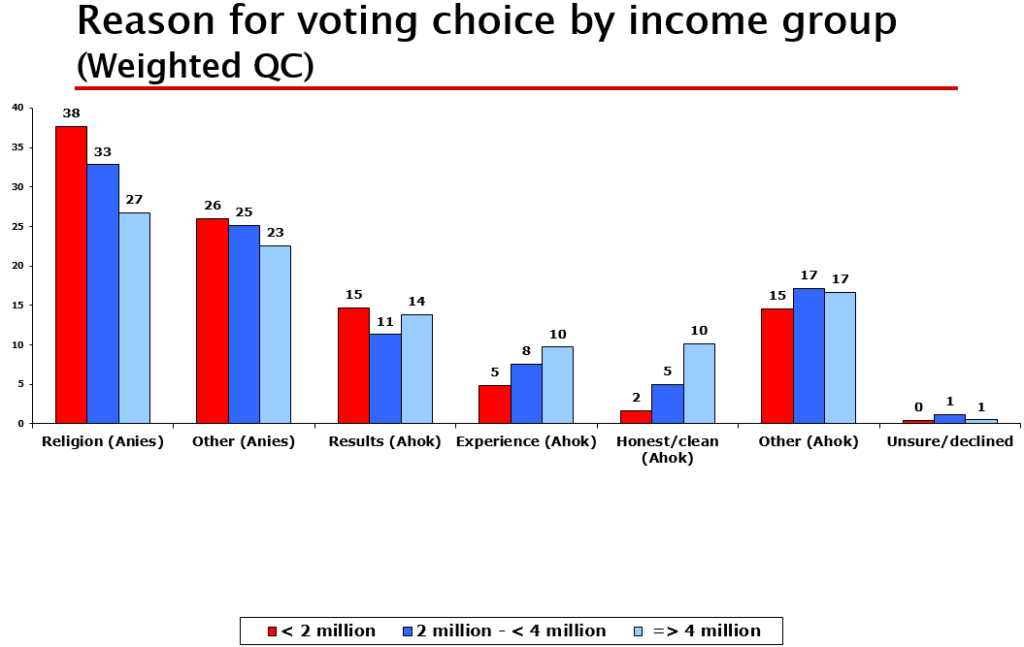
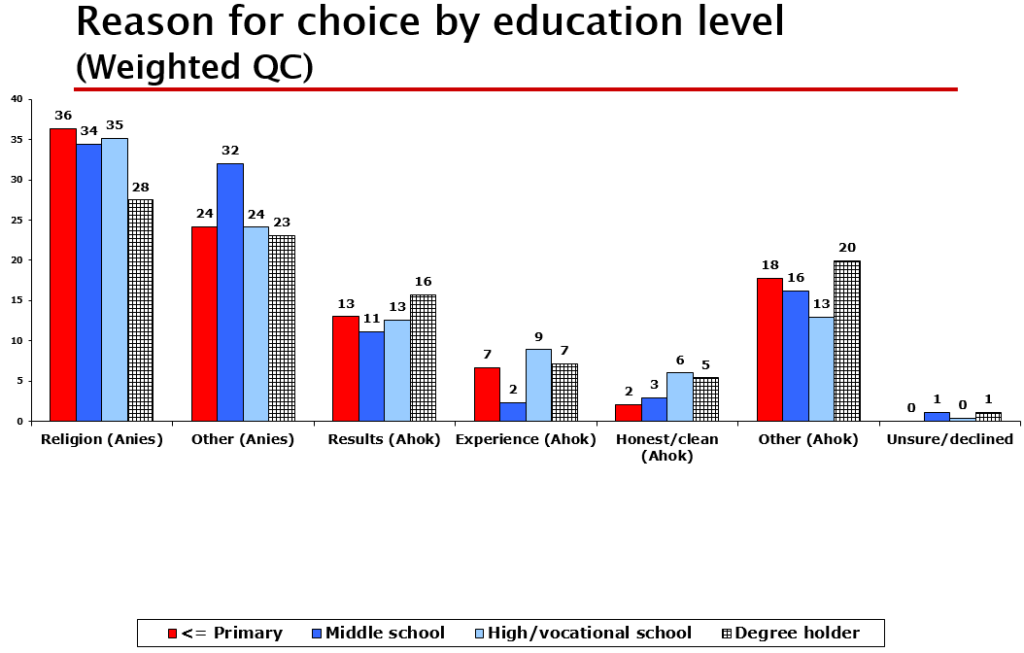
To be fair, some very complicated questions of social desirability bias arise here. Did many middle class voters feel reluctant to openly state their religious prejudices? Did some poorer voters feel prompted to exaggerate the influence of their religious leaders’ instructions to vote against a non-Muslim candidate?
Where ethnicity and inequality intersect
Religion was clearly the primary factor in many voters’ behaviour. But does this necessarily mean that anti-Ahok voters who appear in these polls as religiously-motivated were acting upon narrowly theological concerns? We suggest instead that sectarian voting in this instance may also have been coloured by perceptions of, and anxieties about, wealth distribution. That the data above imply that non-Muslim voters are disproportionately represented in the ranks of Jakarta’s wealthiest citizens already suggests the ways that class and religious identity can intersect.
Ian Wilson made a similar point at the recent forum at Murdoch University when reflecting on his research among urban poor communities opposed to Ahok. To paraphrase, he observed how anti-Ahok Islamist discourses drew explicitly and implicitly on old narratives about the dominance of an ethnic Chinese capitalist class, ‘of whom Ahok was [they felt] the champion’. A racialised, sectarian campaign against Ahok, he said, was a way for many people to channel their frustrations with what they saw as the injustice of that supposedly Chinese-dominated economy.
The politicisation of Chinese wealth in Indonesia does indeed have a long history. Lately, though, certain kinds of concerns about Chinese prosperity have re-emerged at the centre of public debate, particularly since Jokowi entered the national political scene. More and more, it seems that when political leaders talk about inequality and Indonesia’s economic problems, they invoke the spectre of (usually undefined) ‘foreign forces’. Prabowo Subianto’s 2014 presidential campaign is illustrative. He rallied farmers’ groups and labour unions, and claimed Indonesia’s riches and its people were being exploited by antek-antek asing, or the lackeys of foreigners. Prabowo regularly engaged in this sort of dog whistling at public rallies.
Implicit in such rhetoric is a thinly veiled attack on the Indonesian-Chinese business elite, whose connections to Singapore, Hong Kong, and mainland China have long attracted accusations of disloyalty. Former president SBY was playing into these sentiments when he made remarks about minorities having to prove their loyalty in the context of a speech about economic inequality and social justice. Anies Baswedan was playing a similar game during a visit to FPI headquarters in January, where he falsely stated that the Arab minority was the only one to organise itself to fight for Indonesia’s independence.
To be sure, the pattern across most of Indonesia’s elections has been for political candidates to pursue a pluralist political identity, often pairing with a running partner from another ethnic group (see Ed Aspinall’s work on this topic). But things have been harder for the Chinese. During the runoff in the 2010 mayoral race in Medan for example, the Muslim candidate ran an effective campaign that urged Muslim citizens to vote on religious grounds in order to defeat his opponent—an Indonesian-Chinese Buddhist and entrepreneur—which they did en masse.
Beyond electoral politics, we can observe a tendency for influential public figures to explicitly link the problem of inequality to the private wealth of the country’s non-Muslim (read: Chinese) business elite. One striking example was when Vice-President Jusuf Kalla, speaking recently at a Muhammadiyah event, emphasised that inequality in Indonesia falls along religious lines: ‘…in Indonesia, those who a rich and those who are poor are of different religions….a large portion of those who are rich are non-Muslim.’ Meanwhile, said Kalla, the poorest Indonesians are overwhelmingly Muslim.
Another such case came two days prior to Jakarta’s election, when leaders of the Council of Islamic Scholars (MUI) met with reporters fresh out of a meeting with President Jokowi. The president apparently pledged a redistribution of financial assets to Islamic organisations and boarding schools. MUI also claimed that Jokowi promised to ‘force’ Indonesian-Chinese conglomerates (their owners disparagingly referred to as Taipan) to work with and channel funds to Islamic institutions. The agreement was, according to MUI, a way of addressing Indonesia’s inequality problem—which by implication had an ethnic and religious dimension. Assuming the MUI spokespeople reported the meeting accurately (we have seen no denial or clarification from the palace) then it smacks of a Suharto-style social-political contract whereby wealthy Indonesian Chinese must ‘pay their dues’ for the economic prosperity they enjoy.
Strangely, this renewed emphasis on ethnic-Chinese wealth has occurred despite the fact that a major characteristic of the Yudhoyono-era political economy was the emergence of pribumi (‘indigenous’) oligarchs, while under Jokowi—and under Ahok—we have seen the reassertion of state capital at the expense of some oligarchic interests.
Now, it could be said that Ahok’s unpopularity with Muslims is not because of his being a minority per se but rather a result of his supposed blasphemy against the Qur’an, or his generally brash and confrontational personality. But can these factors be separated from widespread expectations about how minorities in public life should relate to an Islamic society, and in particular, racialised norms of how Indonesian Chinese should conduct themselves in the public eye? (A somewhat analogous situation can be seen in the United States. Countless reflections of Barack Obama’s relationship with race politics noted how he had to strain throughout his presidency to avoid being seen as the ‘angry black man’. In Australia, non-white public figures become victims of what one observer has christened the ‘brown poppy syndrome’, illustrated in the past recently by the displays of public outrage over a prominent Muslim commentator’s tactless Facebook post.)
Thomas Lembong, an ethnic Chinese cabinet official appointed by Jokowi, offered a lucid illustration of the stereotypes that accompany elite Chinese-Indonesians:
Ahok often displayed some of our worst traits as elite ethnic Chinese-Indonesians: confrontational, aggressive, brash. It’s a wake-up call for us elite ethnic Chinese-Indonesians, to be more attuned to Indonesian culture, which is soft-spoken and very respectful.
‘We need to make sure, that Chinese investment into Indonesia, which is soaring and which is bringing massive benefits for the Indonesian economy, does not fall victim to our failure, as elite ethnic-Chinese Indonesians, to be better citizens.
Such comments suggest we should view the sectarian campaign against Ahok as having leveraged a deep-seated anxiety about ethnic Chinese prosperity, and the movement of a supposedly wealthy minority into visible positions of political power.
Where to go from here?
Debate in and outside Indonesia on Ahok’s loss runs the risk of falling into two camps—one that emphasises class, and one that emphasises identity politics. But the two are by no means mutually exclusive. Prejudice against the Indonesian Chinese community fuses ethnic difference with a perceived (and often exaggerated) material privilege. This is by no means a new phenomenon: Vedi Hadiz, for instance, has recently explored the role of petty bourgeois Muslim anxiety about Chinese economic dominance in the emergence of ‘Islamic populism’ dating back to the colonial era.
It’s also worth considering the idea that this kind of sectarian campaign resonates beyond what we often call ‘right wing’ and ‘conservative’ Muslims in Indonesia. The campaign against Ahok has prompted plenty of speculation about the rise of conservative Islam in Indonesia. But in truth Indonesians do not have to be of a right-wing Islamist ilk to hold ambivalent views about Chinese Indonesian material and political power: anti-Chinese prejudices of the type we’ve described here exist on the nationalist side of Indonesia’s political spectrum as well.
Discussing economic justice in Indonesia requires us to consider the racialised and religious terms in which it often understood. Likewise, any discussion of identity politics as it pertained to the Jakarta election should not write class out of the picture. So while the data tell us that many Jakartans voted along religious lines, it may also be the case that voters—regardless their socio-economic background—viewed Ahok through the prism of an old ethnoreligiously-coloured economic anxiety.
(Our thanks again to Burhanuddin Muhtadi and staff of Indikator Politik Indonesia for preparing the exit poll data that appear in this post, and to colleagues for their feedback on the text.)
……………
Eve Warburton is a PhD Candidate at the Department of Political and Social Change at the Australian National University’s Coral Bell School of Asia Pacific Affairs, researching resource nationalism in contemporary Indonesia. Her recent article Jokowi and the New Developmentalism is available for download from the Bulletin of Indonesian Economic Studies.
Liam Gammon is a PhD candidate at the same department, and is the editor of New Mandala.
Header photo: a pedestrian transporting a sack of goods across a footbridge in central Jakarta, with the logo of the Singapore-owned United Overseas Bank in the background. Taken by Liam Gammon.
 Facebook
Facebook  Twitter
Twitter  Soundcloud
Soundcloud  Youtube
Youtube  Rss
Rss 